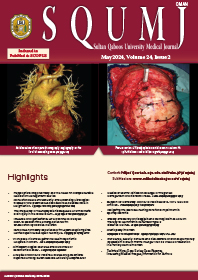Main Article Content
Abstract
Objectives: This study aimed to determine the rate and severity patterns of bronchopulmonary dysplasia (BPD) and identify antenatal and postnatal factors associated with BPD in preterm infants <32 weeks of gestational age (GA). Methods: This retrospective observational study included preterm neonates <32 weeks of gestation admitted into the neonatal intensive care unit between January 2010 and December 2017 at Sultan Qaboos University Hospital, Muscat, Oman. A data set of antenatal and perinatal factors were collected. BPD was defined as the need for oxygen and/or respiratory support at 36 weeks post-menstrual age (PMA). Infants with and without BPD were compared in their antenatal and perinatal factors. Results: A total of 589 preterm infants <32 weeks were admitted. Among them, 505 (85.7%) survived to 36 weeks’ PMA and 90 (17.8%) had BPD. The combined BPD and mortality rate was 28.4%. Grades 1, 2 and 3 BPD constituted 77.8%, 7.8% and 14.4%, respectively. BPD was associated with lower GA, lower birth weight, need for intubation at resuscitation, lower Apgar scores, longer duration of ventilation, surfactant therapy and higher rates of neonatal morbidities. On binary logistic regression analysis, predictors of BPD were longer duration of ventilation, intraventricular haemorrhage (IVH) and necrotising enterocolitis (NEC). Conclusion: In an Omani centre, 17.8% of preterm infants (<32 weeks GA) developed BPD. Various perinatal and neonatal factors were associated with BPD. However, longer duration of ventilation, IVH grades 1 and 2 and NEC stages II and III were significant predictors. Future multicentre research is necessary to provide the overall prevalence of BPD in Oman to help optimise the resources for BPD prevention and management in preterm infants.
Keywords: Infant; Premature Birth; Bronchopulmonary Dysplasia; Risk Factors; Oman.
Article Details

This work is licensed under a Creative Commons Attribution-NoDerivatives 4.0 International License.
